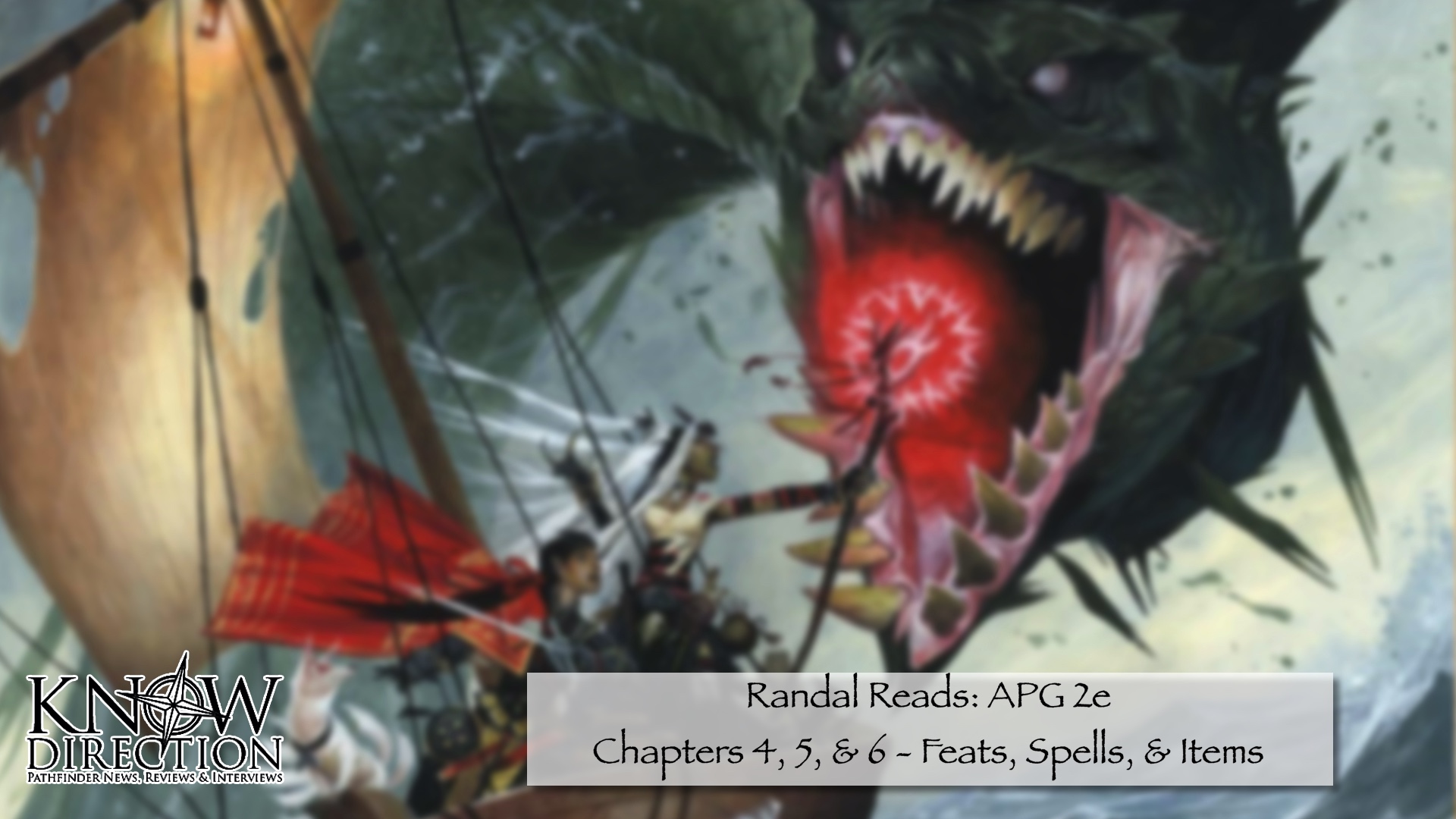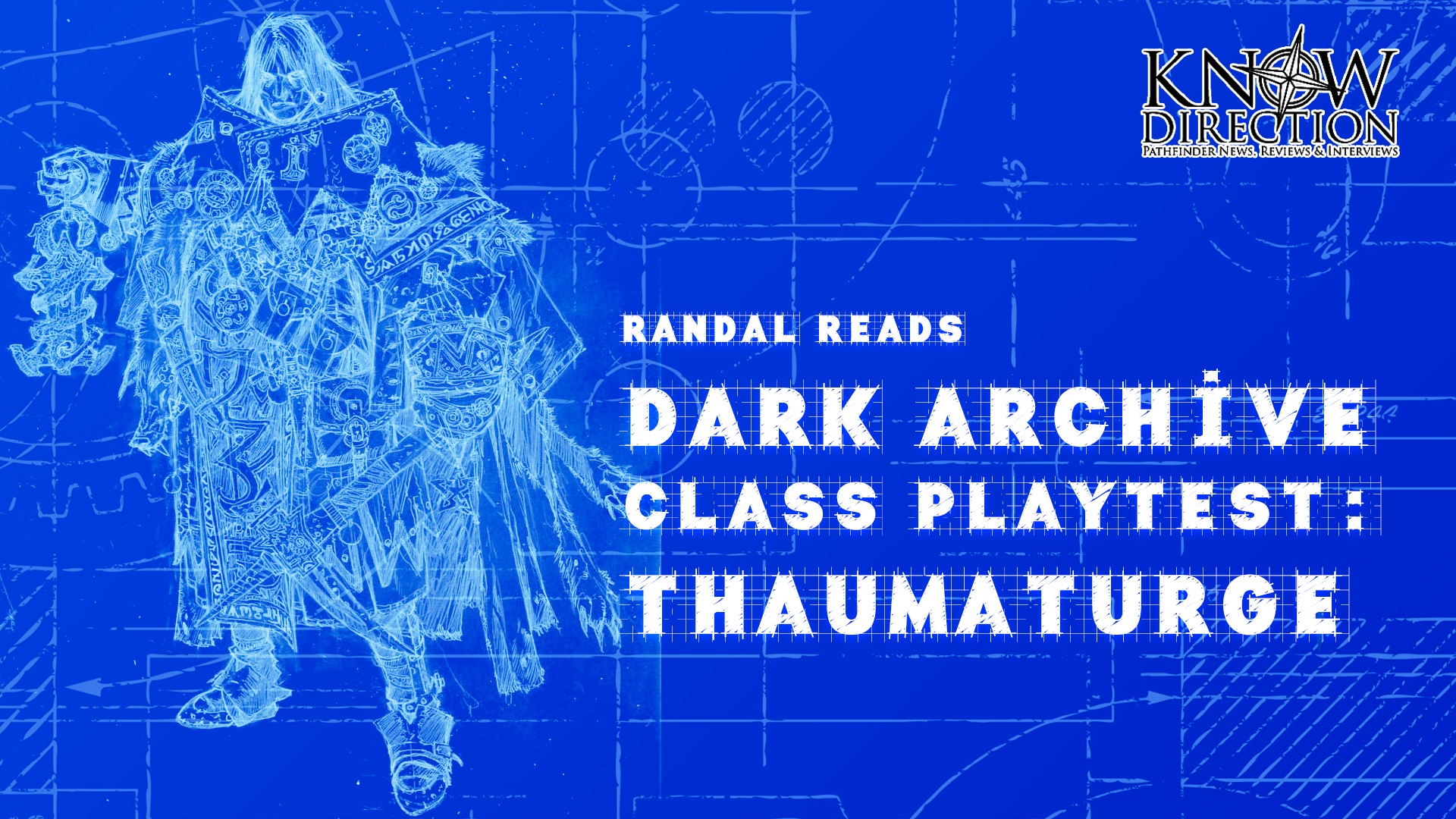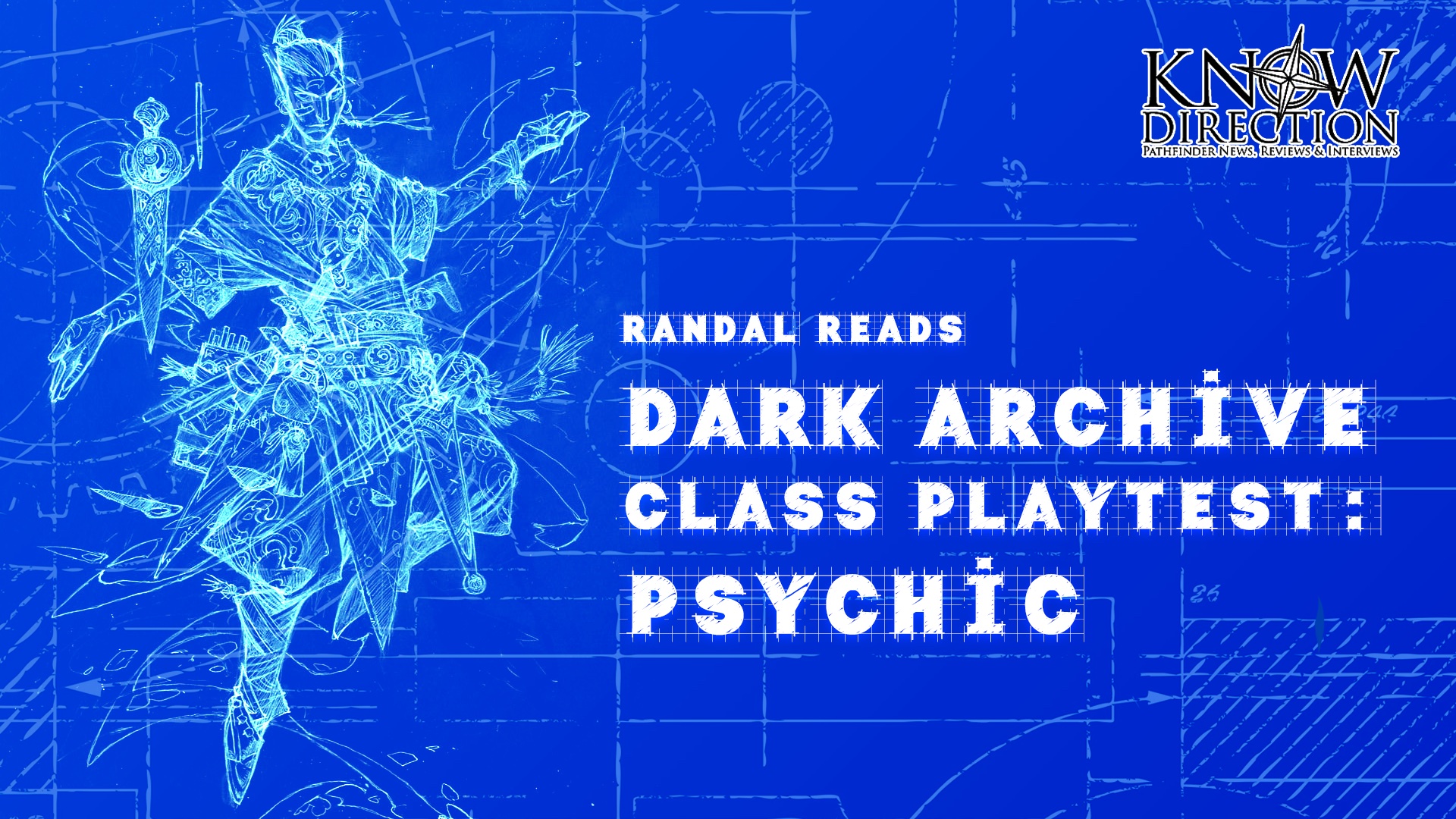Welcome back to the continuation of the Advanced Player’s Guide special review blog! If you missed the beginning, you can find it here! We finished the archetypes yesterday, moving us to the lightning round … feats, spells, and more!
I don’t want to waste your time listing feats, spells, or items and describing them. It makes sense to distill ancestries, heritages, classes, and archetypes to a paragraph or two each … but if I were to pare down these to a blurb I would just be copying the work already done in the tables that lead each section. Those you can quickly flip to and read in your book, your pdf, and on Archives of Nethys.
Chapter 4 – Feats
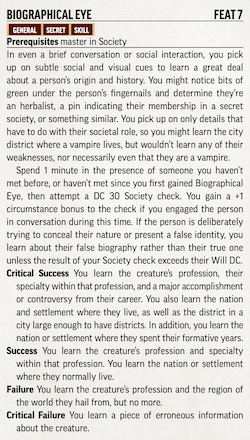 The feats chapter is a mixed bag of options. There are some feats that seemed designed to just expand options from the CRB, mostly in the Society skill feats. There are many that were either intended to play well with new classes, for instance Biographical Eye (7th, skill; learn about a person by looking at them) works well with investigator but can be helpful to any character that wants to play detective … or bounty hunter. Others were more directly tied to the classes such as Bon Mot (7th, skill; distract with a quip) is given to Swashbucklers that choose Wit as their style. I am pretty sure at least one archetype gave or offered access to a new skill feat as well. I think they provided a nice collection of new 1st-level feats to keep new builds interesting and different. Many of them as simple as doing an activity with a different skill check due to your specialized training. I like the exploration activity modifying feats, too, that let you do better when others are following you as the expert, or let you do better when following somebody else as the expert.
The feats chapter is a mixed bag of options. There are some feats that seemed designed to just expand options from the CRB, mostly in the Society skill feats. There are many that were either intended to play well with new classes, for instance Biographical Eye (7th, skill; learn about a person by looking at them) works well with investigator but can be helpful to any character that wants to play detective … or bounty hunter. Others were more directly tied to the classes such as Bon Mot (7th, skill; distract with a quip) is given to Swashbucklers that choose Wit as their style. I am pretty sure at least one archetype gave or offered access to a new skill feat as well. I think they provided a nice collection of new 1st-level feats to keep new builds interesting and different. Many of them as simple as doing an activity with a different skill check due to your specialized training. I like the exploration activity modifying feats, too, that let you do better when others are following you as the expert, or let you do better when following somebody else as the expert.
I wanna call out a couple feats that I found fun and interesting. Pilgrim’s Token (1st, skill) is simple, has great flavor, and has a nice mechanical boost without doing much (you break ties in initiative). Keen Follower (3rd) lets you gain a higher bonus while following the expert if said ally is Expert or Master in the skill related to the activity. Consult the Spirits (7th, skill) is neat, fun, and paints a picture … depending on the skill you choose (Nature, Occultism, Religion) you can commune with different types of spirits to get a sense of things in an area with a Recall Knowledge. (I woulda screen-capped it, but it spilled over to a second column.)
Note: Be aware that the Concealing Legerdemain appears to have the wrong text for the Benefits column of the feats table. It says “using Stealth instead of Thievery” … but the feat requires Thievery and the actual feat says “use Thievery instead of Stealth”
Chapter 5 – Spells

Standard Spells
Ok, as mentioned in my CRB review, this is usually my favorite part … but with all the new content so far, I think it will be hard for spells to make that big a splash. Right out of the gate, they listed the page numbers from CRB and APG of the four tradition spell lists and the groupings of standard spells, focus spells, and rituals. Plus I thought the sidebar for components was a nice bit of added context for players that may not be as deep in the system as some of us might be. I think I counted 7 spells with the Curse trait, I assume for the witches in the house.
It was nice to see that it is now Transmute Rock and Mud (5th; arcane, primal) instead of being two opposing spells. It wasn’t the only returning spell that I was glad to see … Vomit Swarm (2nd; arcane, occult, primal) is always fun, as are Enervation (4th; arcane, divine, occult), Heat Metal (2nd; arcane, primal), Animate Dead (1st; arcane, divine, occult), Animate Rope (1st; arcane, occult), and more. Some spells I don’t recall seeing before that look like fun are Mad Monkeys (3rd; primal), Reaper’s Lantern (2nd; divine, occult, primal), and Final Sacrifice (2nd). I really feel like Final Sacrifice was put there to pair up with Animate Dead … but I also think it might be a bit of bit for those characters walking the line with evil alignments.
Focus Spells
Focus spells are even less interesting to discuss now because I sort of already covered them when discussing class feats that gave access to them (even if I did just gloss over the spells then). My shout outs include Hymn of Healing (Bard, 1) because I guess I miss the healing bards of 1e, Ki Form (Monk 9) because who doesn’t wanna go Super Saiyan, Moonlight Bridge (Oracle 6) because I really liked the visual I got, Malicious Shadow (Witch 3) because that is some horror trope stuff.
Rituals
I really liked the list of rituals that appeared here. The 2nd level Heartbond lets you always know where your bonded is, and can message at will, or telepathy at will if you perform the 6th-level version. Astral Projection, Clone, Create Demiplane, Reincarnate, Simulacrum, and Teleportation Circle are all back and rocking it as rituals. I look forward to figuring out which rituals my characters are going to seek out for their homes, lairs, and other activities …
Chapter 6 – Items
Weapons and Adventuring Gear
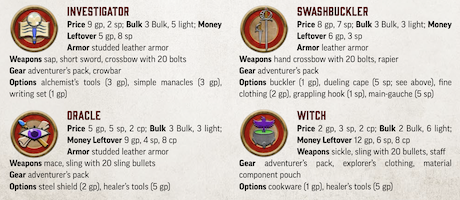 We have new weapons that make sense for our new class and ancestry offerings. Included in these new weapons, are two new weapon traits: Concealable (Sword Cane) and Ranged Trip (Bola). Our gear includes a Detective’s Kit … and we also have class kits for the four new classes (in case you were wondering). The dueling cape and parrying scabbard make an appropriate appearance as well.
We have new weapons that make sense for our new class and ancestry offerings. Included in these new weapons, are two new weapon traits: Concealable (Sword Cane) and Ranged Trip (Bola). Our gear includes a Detective’s Kit … and we also have class kits for the four new classes (in case you were wondering). The dueling cape and parrying scabbard make an appropriate appearance as well.
Alchemical Items
Of the bombs, I was drawn to the Ghost Charge … though it seems to just be a purely alchemical holy flask bomb/grenade. The Drakeheart Mutagen also caught my attention … as did the return of sovereign glue and universal solvent.
Snares
This section was short, simply 4 items: Engulfing Snare, Flare Snare, Nauseating Snare, and Snagging Hook Snare … and their names are fairly descriptive.
Consumable Magic Items
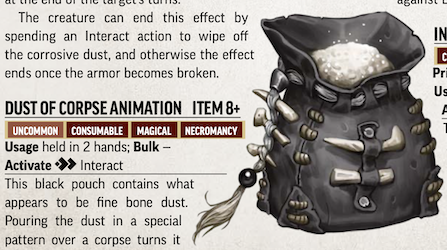 Practical items like Ration Tonic are always welcome at my table … but of course I would rather have Dust of Corpse Animation! (I would settle for Oil of Object Animation.)
Practical items like Ration Tonic are always welcome at my table … but of course I would rather have Dust of Corpse Animation! (I would settle for Oil of Object Animation.)
Permanent Magic Items and Runes
The new runes found here are Fearsome (6+; frighten on crit hit), Ready (6+; 3-action don armor), and Winged (13+; 1/hour fly speed). The Four-Ways Dogslicer is a great precedent for making weapons with variable rune functionality. Walking Cauldron in my Witch’s Hut … yes please! The staves are nice (Impossible Visions – 6+, Nature’s Vengeance 10+, Providence 6+) and I look forward to getting that Nature’s Vengeance for my druid. Of note, the big item in the room is the return of the Rod of Cancellation (20th) … it can power down an item for 2d6 hours, during which time it also powers down; if you wanna completely remove magic from an item you can, by also completely removing magic from the rod. Still powerful, and still worthy of an entire quest or AP I think.
Summary
Well, there you have it, my thoughts on the entirety of the Advanced Player’s Guide for Pathfinder Second Edition. This last post was a bit of a blur after how much I had to say about all the ancestries, heritages, classes, and archetypes … but I think it was for the best that I didn’t comment on every item … after all, you need to read it cover-to-cover yourself! All in all, I think this was a great addition to the game, and hit all the marks that Paizo set out to accomplish with the book. Although I would have liked to see a few things in here that weren’t (arcanist style feat options, magus archetype) I am so effing excited to be able to implement these new options into my games. I am also looking forward to rebuilding some 1e characters, as well as writing up more custom content to expand on the new options (or fill in gaps).
Perhaps I will see you again in a year with when they release Secrets of Magic?
Thank you for reading along, I hope you enjoyed this review. Please join us at our Discord server https://discord.gg/Rt79BAj to let me know what you think, share what you are most looking forward to using in your game, or to simply have a chat!

